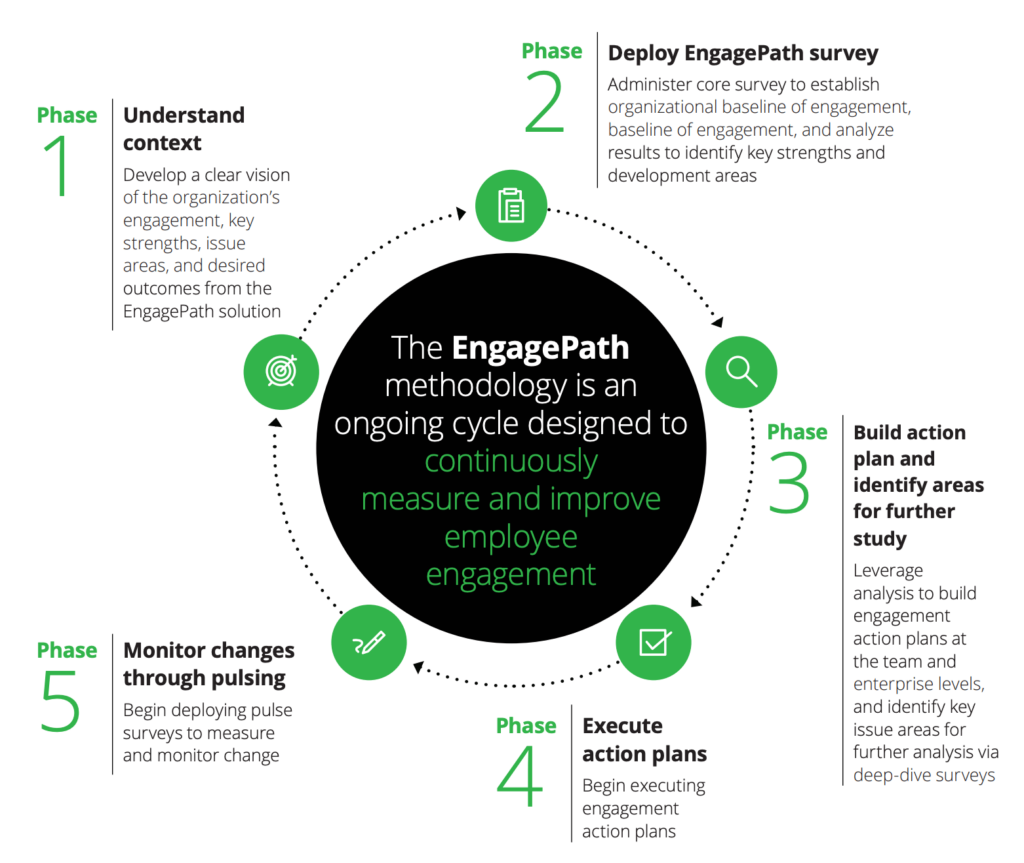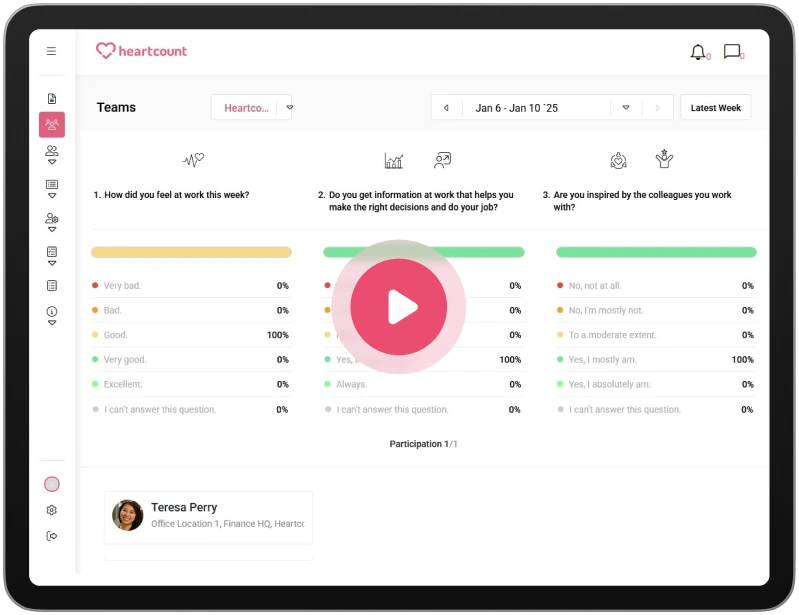Enhancing the social part of ESG reports with HeartCount

We’re seeing a surge of ESG and sustainability reports from companies, big and small.
Legal frameworks like the UN Sustainable Development Goals (SDG) and the EU Corporate Sustainability Reporting Directive (CSRD) are driving the rise of ESG and sustainability reporting, pushing organizations to be transparent about their economic, social, and governance impacts, and making ESG reporting a must-have part of a modern corporate strategy.
Each component of the ESG report (environmental, social, governmental) needs to demonstrate the company’s commitment in that area. When it comes to the social part of the ESG report, overcoming challenges such as regulatory compliance, data collection accuracy, or stakeholder expectations is vital for companies to demonstrate their commitment to social responsibility.
We’re seeing a surge of ESG and sustainability reports from companies, big and small.
Legal frameworks like the UN Sustainable Development Goals (SDG) and the EU Corporate Sustainability Reporting Directive (CSRD) are driving the rise of ESG and sustainability reporting, pushing organizations to be transparent about their economic, social, and governance impacts, and making ESG reporting a must-have part of a modern corporate strategy.
Each component of the ESG report (environmental, social, governmental) needs to demonstrate the company’s commitment in that area. When it comes to the social part of the ESG report, overcoming challenges such as regulatory compliance, data collection accuracy, or stakeholder expectations is vital for companies to demonstrate their commitment to social responsibility.
Why must ESG reporting align with institutional requirements?
This “rise of ESG reporting” makes adapting the ESG reporting to institutional requirements necessary due to:
- Increased investor demands – Investors are shifting their preferences towards companies with more robust ESG performance.
- Corporate accountability – Stakeholders demand greater accountability from the company concerning their social impact.
- Transparency – Standardizing ESG metrics and reporting makes it easier for companies to report on their ESG performance than before.
- Regulatory pressure—ESG disclosure is increasingly mandated by regulatory bodies, such as the EU’s Sustainable Finance Disclosure Regulation (SFDR).
- Risk management – By proactively addressing environmental and social factors through effective ESG practices, companies can better manage their risks and avoid potential legal penalties and reputational damage.
- Long-term financial performance – Companies with high ESG ratings outperform their counterparts by more than 4% on annual returns (12.9% vs 8.6%).
Importance of employee well-being, loyalty, and morale in ESG
The social part of ESG reports concerns how the company interacts with the communities in which it operates, its employees, customers, suppliers, and other stakeholders.
Here’s why this is important.
- Increasing investor confidence
Social factors are vital for investors in making investment decisions. According to the Bankrate’s ESG investing statistics 2023 report, 89% of investors consider ESG when making investment decisions.
In other words, companies with strong social responsibility are seen as more sustainable in the long term and less risky.
- Regulatory compliance
Companies must ensure they meet regulatory standards regarding corporate social responsibility to avoid legal and financial penalties and reputational damage.
- Reputation management
Finally, a weak social performance can lead to poor brand image, lower customer loyalty, and public backlash.
Actionable insights into employee sentiment, engagement, and overall workplace culture are essential for a company to have a solid social component in its ESG report.
This is where pulse-check surveys and employee well-being data can be tremendously helpful. They provide continuous feedback mechanisms, help companies better understand employee needs, make data-driven decisions, and support diversity and inclusion efforts.
Here is how conducting frequent and regular pulse-check surveys can help improve employee well-being, loyalty, and morale:
Employee well-being
Pulse-check surveys are an excellent channel for employees to voice their feelings and concerns about their stress, overall mental health, and workload. By conducting regular surveys and assessing these factors, your organization can detect areas where you can support struggling employees.
Furthermore, pulse-check surveys help the company better understand its employees’ well-being. This allows it to introduce programs, initiatives, and policies that promote a healthier work-life balance.
Caring about employees’ well-being eventually gets rewarded, as employees who see their employer is genuinely concerned and cares about their well-being will have a higher emotional connection to the workplace and job satisfaction.
Employee loyalty
Conducting regular pulse-check surveys signals to employees that “your opinions and feedback matter to us.”
Of course, your organization needs to act on that feedback to show it is committed to improving the workplace. Employees don’t just want to be heard (although that matters a lot). They also want their concerns addressed. If they see that their feedback doesn’t fall on deaf ears but something is being done about it, they will have fewer reasons to leave.
Employee morale
Finally, pulse-check surveys help uncover valuable insights into employee engagement and morale levels. This allows your organization to create a more positive work environment.
If the results of these surveys are tangible improvements, this is a clear message to employees: “You are valued.” Few things in the workplace can boost employee morale quite like this.
COLLECT
Methodologies: Pulse check surveys and reports
Pulse check surveys
Pulse-check surveys are conducted weekly or monthly, depending on the organization’s needs. They are much better at ” catching” emerging issues and trends on time than traditional annual surveys.
For example, with tools like HeartCount, you can conduct (bi)weekly surveys and generate a Semiannual report based on the data you gather during these surveys. The report showcases the state of your workforce and is available twice a year (January 15th and July 15th) in the report section on the left side of your dashboard. You won’t need to spend endless hours collecting and processing data and creating specific displays. You can click download, print, and include a ready-made report on your workforce’s well-being, autonomy, and loyalty, among other parts of the record.
Pulse-check surveys are also focused. They usually consist of 3-10 straightforward questions, each tackling a specific aspect of the employee experience (workplace culture, job satisfaction, etc.).
Anonymity is another crucial component of pulse-check surveys that is well worth considering. By giving employees this option and ensuring their responses are confidential, you increase the chances of getting more honest feedback and employees expressing their true feelings.
Finally, your organization can use this insight to improve employee engagement and satisfaction.

Employee well-being reports
Employee well-being reports are vital in evaluating and improving employee health and satisfaction. They focus on health metrics, safety records, and support programs.
- Health metrics
Health metrics include absenteeism rates, engagement scores, mental health indicators, and health records.
For instance, an employee’s high absenteeism rate can indicate deep dissatisfaction or underlying health or mental problems. Data from health insurance providers, like BMI or blood pressure, can also help identify areas of employee health that need attention.
- Safety records
Working in a safe workplace is also vital for individual employees’ physical and mental health, so ensuring compliance with health regulations is vital.
This includes conducting regular safety practices audits and training programs, documenting incidents, and gathering employee feedback.
For example, Nestle, in its Sustainability Report 2023, empowers its employees to voice their concerns about work safety using the Speak Up platform in its ongoing effort to ensure the highest safety standards in all its sites, operations, and projects.
- Support programs
Finally, providing your employees with support programs such as training and development opportunities, wellness programs, or employee assistance programs (EAPs) is highly beneficial for enhancing employee well-being and promoting work-life balance.
For instance, in its sustainability report, BMW Group highlights that over 5,000 out of 154,950 employees participate in the NFP young talent promotion programs.
This demonstrates your commitment to employee well-being and increases job satisfaction, retention, and productivity.
Loyalty and morale reports
Loyalty and morale reports are crucial for assessing employee retention, engagement, and overall job satisfaction.
They focus on engagement scores, turnover rates, and career development opportunities.
- Engagement scores
Engagement scores measure employees’ motivation, enthusiasm, and commitment to their jobs and the company. The higher the engagement score, the more invested and passionate the employees are in the company and its goals.
Deloitte, for instance, takes great care to measure and manage employee engagement consistently and can translate these results into action.
Their approach is to use the EngagePath framework. This framework consists of five phases (understanding context, deploying the EngagePath survey, building around the action plan and identifying areas for further study, executing the action plan, and monitoring changes through pulsing), each phase leading to the next and forming a circle.
- Turnover rates
Turnover rates represent the percentage of employees who leave the organization over a certain period. Lower retention rates mean low loyalty, engagement, and satisfaction, which can be exasperated by poor work-life balance, a lack of career development opportunities, and other factors.
Most companies are reluctant to disclose their turnover rates publicly (another thing that regulatory pressure aims to change). Still, such information can be vital for investors and stakeholders to understand the company’s health.
Transparency is key here, as we can see in the Starbucks 2023 Global Impact Report, where they disclose their turnover rates for the US and Canada for FY (fiscal years) 2022 and 2023.
- Career development opportunities
Career development opportunities are vital for maintaining high employee loyalty and morale. Such reports must assess the effectiveness and availability of career development initiatives, such as training and upskilling programs, coaching and mentorship programs, and leadership development opportunities.
Focusing on providing these opportunities to your employees promotes a sense of purpose and commitment among them, leading to lower turnover rates but higher motivation, engagement, and loyalty.
This, however, goes beyond providing opportunities only for your employees. In its 2023 Sustainability Report, Amazon set a goal to help 29 million people globally grow their technical skills by 2025 (currently at 21 million as of the last report).
Benefits of crafting the social part of ESG reports
The social part of the ESG report provides invaluable insight into how the company interacts with its employees, customers, and the community it’s a part of.
For organizations that aim toward good stakeholder relationships and high sustainability practices, crafting the social aspect of ESG reports is essential.
The benefits of focusing on the “S” component of ESG include:
Data-driven decision making
Organizations can make more informed and data-driven decisions by including social metrics in their ESG reports and identifying trends and areas for improvement to focus on based on engagement scores, turnover rates, and so on.
This way, the company can set clear and measurable goals and track its progress over time, ensuring its efforts align with and benefit the overall company objectives.
Enhanced transparency
Today, stakeholders hold companies to high standards regarding their social responsibility. Greater transparency is another “product” of a comprehensive social component of ESG reporting. This builds trust with employees, customers, and investors.
Improved stakeholder engagement
Organizations must actively involve their stakeholders in reporting to understand their needs better. This will be a valuable platform for stakeholder feedback and dialogue and will strengthen their relationships.
Benchmarking and continuous improvement
Comparing your organization’s social metrics against industry standards and best practices can help you identify performance gaps and areas for improvement.
Through benchmarking the social part of ESG reports, you can encourage continuous improvement and track your progress over time.
Regulatory compliance and risk management
A well-defined social aspect of the ESG report enables organizations to stay compliant with shifting regulations.
Thorough social reporting illustrates the company’s commitment to ethical practices and managing social risks to regulators and stakeholders.
Social risks such as public backlash, labour disputes, or discrimination claims must be proactively addressed as scrutiny increases for the company to assuage potential legal and reputational threats.
For example, many of HeartCount’s clients solved certain employee mistreatment situations thanks to the Pulse Check Feedback box, which allows clients to send direct, anonymous, and transparent feedback to the HR department, management, or executive directors.
Conclusion
As many as 76% of consumers would stop buying from a company that disregards environmental, community, or employee well-being, highlighting the social impact of ESG practices on consumer behaviour.
And it’s not just consumers who are deeply interested in your ESG reports. Investors, other stakeholders, regulators, and others will all scrutinize it. Their opinions and decisions based on your ESG report can “make or break” your company.
This is why it is essential to present them with an ESG report that showcases your company’s performance and initiatives, provides transparency to stakeholders, and represents it as an excellent investment opportunity.
Is this the first time an ESG report has been done? Don’t worry. Contact us and schedule a call with our consultant to ease the process.












